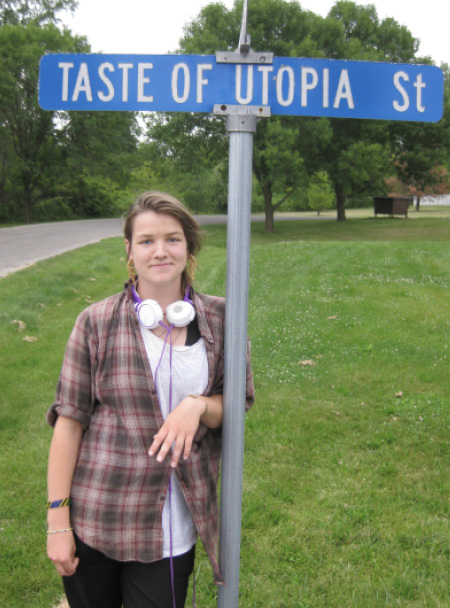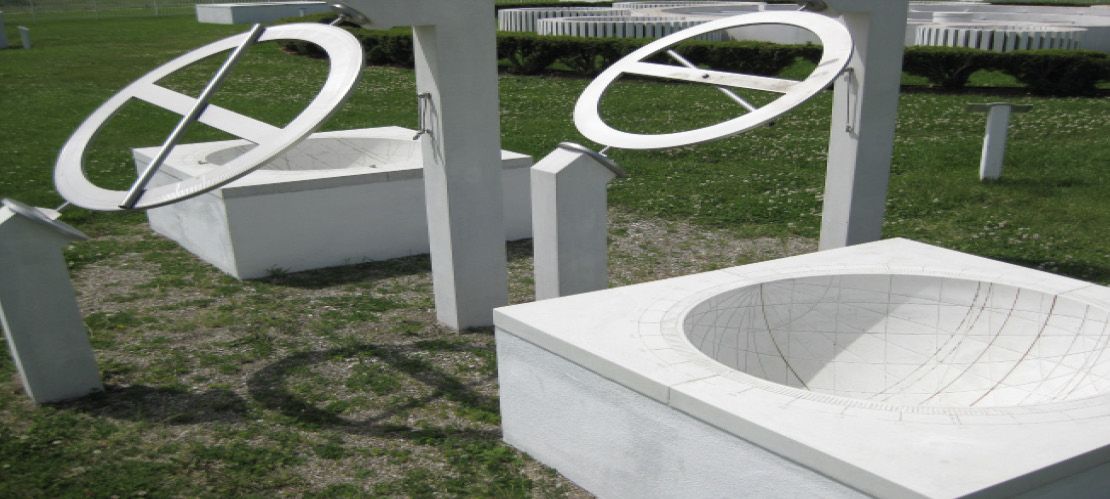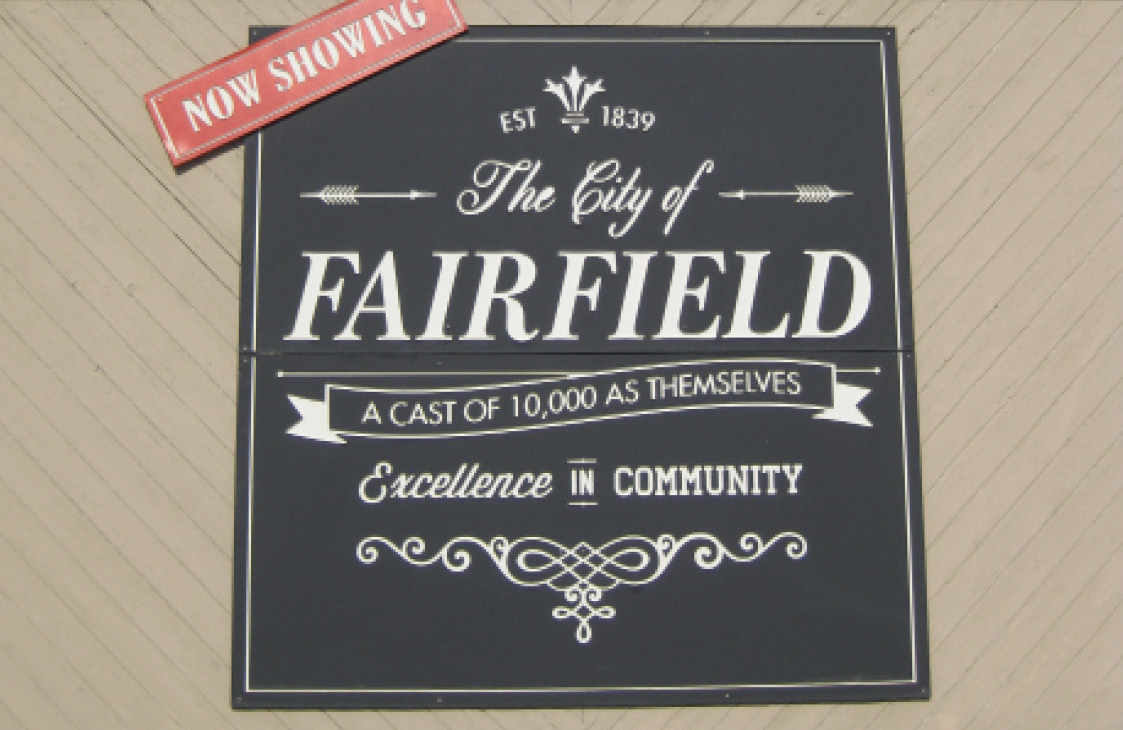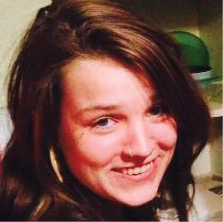Note: To preserve the anonymity of her informants in Fairfield, Atmore adopted the following system to cite quoted or paraphrased statements from them. Each informant received a number (1, 2, 3, etc.), and the citation includes the person’s number and the date of the interview.
I meet up with my guide in the Argiro student center just as she finishes a summer class she’s teaching. She’s a Maharishi Vedic Science (MVS) Ph.D. student at Maharishi University of Management (MUM) and she has agreed to show me the domes today. Vastu architecture requires all buildings to be surrounded by a white fence, and as we enter the gate I have a feeling that I have just passed a metaphorical threshold. I close the latch behind us and make sure my face is composed to reveal none of my incredulity, excitement, and skepticism. I turn around and face the Bagambhrini Golden Dome for the lady meditators. Here we go….
We enter a set of glass double-doors into a coatroom with shelves for shoes, much like in a Hindu temple. We take off our shoes and go through another door into a small foyer with a plush rug and a few bulletin boards. I am reminded of a church; the room you enter before going into the chapel, where the old women meet, have coffee, and gossip and where the community events are advertised. A sign that recommends ‘silence’ greets us as we go through another set of doors and finally this time into the Dome itself. A vast circular room opens up in front of me with the curved wooden ceiling rising surprisingly high and ending in a glass skylight underneath the spire rising from the top that is visible from the outside. However, the ceiling is not the first thing I notice.
The first thing I notice here is the expanse of mattresses lining the floor of the Dome and continuing further than it seems it should. On the mattresses are vertical structures called “back-jacks” which people use as back support for extended meditation. The back-jacks are colorful in contrast to the white, yellow, gold, and brown of the mattresses, walls, and ceiling. Around the edge of the room, near the windows, are comfortable armchairs, presumably for elderly meditators who have trouble sitting on the mattresses.
I am awestruck by the room in front of me. It’s beautiful; the kind of vast space where you feel the quantity of atmosphere around you and speaking at normal volumes seems like sacrilege. I am led to the center of the Dome and a little off to the right, where there is a section of mattresses without back-jacks. This is my guide’s customary spot, the Yogic Flying ring. “For those of us Yogic Flyers who are flexible enough to achieve full lotus,” she says as she plops down and folds her legs into a pretzel.
We sit on the mattresses and talk. After we’ve been in the Dome for about half an hour, people start trickling in. Time to go, I thought to myself. I’m technically not supposed to be here, especially not during meditation time. We head back across the Dome, back through the meeting area, where women are starting to come in and greet each other, and into the coatroom. We put our shoes on and soon we’re back through the gate in the normal world again.
My visit to the Yogic Flying Dome in Fairfield, Iowa, occurred in the summer of 2016, while I was living in Fairfield for two months conducting ethnographic research on the relationship between spirituality and environmental sustainability in the TM community there. My visit to the Dome, while not obviously relevant to sustainability, occurred during my last week in Fairfield after spending nearly two months in the town and was a way for me to gain a deeper understanding of Fairfield’s unique brand of spirituality: Transcendental Meditation and the teachings of Maharishi Mahesh Yogi, a guru from India.
Transcendental meditation is a mantra-based meditation technique brought to the United States by Maharishi in 1959. Originally, his movement was not called “Transcendental Meditation”, but the “Spiritual Regeneration Movement” (5, July 2). However, concerned at the reception of U.S. citizens to the idea of spirituality, Maharishi decided to focus on the physiological benefits of the technique. TM was advertised as a mechanism for improving your body, brain, and life overall:
Maharishi comes over here in like the early 1960’s and starts promoting this as like a health thing because at some point he realizes that this is the only way he can get traction. And at first he resisted it and then he’s like, okay it doesn’t really matter if somebody just starts doing this to get rid of their headaches and then they get enlightened. It’s a win-win (4, June 29).
The movement became very popular among college students and members of the 60’s counter culture. TM was seen as an alternative lifestyle and was embraced enthusiastically.

Photo courtesy of Lane Atmore
The experience of transcendence, I was told, is something all humans have experienced before (6, July 7). It is the feeling you get when you have an intense reaction to something, be it a beautiful landscape, the sunset, looking into the eyes of someone you love, or something else. When this happens, you experience the feeling that there is something larger than you out there, for example when you lie on your back and stare up at the stars and have the sensation that you are one tiny being in the vastness of the universe. So the feeling achieved through TM is something that we have all experienced before, even if we’ve done so unintentionally. TM, according to this explanation, is the intentional experience of this feeling on a regular basis. This connection with that larger entity, that “consciousness”, as it is known in TM, changes your life, your mind, and your worldview.
For most people, TM is simply a meditation practice and does not involve belief in anything. Meditators are free to adhere to any religion, spirituality, or worldview they wish as long as it does not interfere with their meditation. For others, TM is much, much more than a simple technique. In Fairfield, TM has become institutionalized in a way that is strongly reminiscent of religion. MUM is an institution that is based on Maharishi’s philosophy, and students are required to take what Maharishi said at face value, not to mention the Developmental Consciousness requirements.
Most people, when asked what is the difference between spirituality and religion, will say that spirituality is subjective and personal, while religion is institutionalized and involves ritual. While much of Maharishi’s philosophy may generally fall into the “spiritual” category, there is no denying the institutionalization of Maharishi in Fairfield and the presence of ritual surrounding this institution. While the official line is that TM is not a form of spirituality, several interviewees told me that in Fairfield, the idea of “consciousness” is synonymous with “spirituality” and that part of the strength of this community is that they all share a common worldview (1, June 12; 5, July 2).
During my first week in Fairfield I was walking around the MUM campus with an acquaintance. He was telling me about the school, the administration, TM, and Fairfield at large. As we were walking through the Argiro building, the student center on campus, this acquaintance looked around, lowered his voice and said, of the movement as an entity, “It’s something that starts with a ‘c’…”. That word was “cult,” and if I was surprised to hear it at first, it became a very common phrase used by many people in Fairfield, both meditators and non-meditators alike, to describe what is going on in Fairfield. “It’s an institution that controls the way you think and live, what else could you call it?” he continued (15, June 4). Similar sentiment was expressed to me from various sources, including a cutting example provided in interview 4:
I have students from … Utah. And I also have a student who said the same thing who was raised—his mom was a Scientologist. And they both said, “Look, we came from cults. We know what a cult is. This is a cult.” And like, other students who were Catholics, who came and were like, “Look I left my home to get away from dogma and I came here and it’s just dogma.” (4, June 29)
Interviewee 4, and many others I spoke to, also mentioned censorship of information at MUM (1, June 12; 13; 15; 16; 17; 18; 22). Guest speakers at MUM are given thorough background checks before they are allowed to come onto the MUM campus (14, June 1; 15, June 16; 16, June 16). I’ve even been told that if sustainability speakers discuss the use of mushrooms in permaculture, a taboo food among the movement, they are not allowed to speak on campus (15, June 16; 16, June 16).
There are many individuals in the Movement who are desperate for change, yet are incapable of achieving it. When an entire culture is accustomed to taking one individual’s word as Truth, it is hard to see otherwise:
So there’s again another weird tension between, here’s this practice that can be genuinely secular and here’s this ideology that goes way beyond the practice into every facet of life. And the people who are at this institution are here because in some way he was their guru. And part of the narrative says that he was enlightened. Which means that whatever he says was true so then you just have to do it. (4, June 29)
Here we have an institutionalized worldview that has become a system that explains itself. However, this doesn’t mean that all practitioners of TM are close-minded. Instead, it is that some in Fairfield think that a group of fundamentalist thinkers is running the Movement, whether or not this is actually true.
Many newer residents of Fairfield come for other reasons apart from believing Maharishi’s teachings are the end-all-be-all of existence: “…I’m totally interested in the consciousness aspect as an academic, not as somebody who’s looking for a guru. Not as somebody who’s looking to, just, check my critical thinking at the door, right?” (4, June 29). But attempts to change the system are frustrated across the board because TM has become a “closed system,” a “conservative paradigm that overshadows progressiveness” (2, June 23). It is this restrictiveness in knowledge and the lack of critical thinking, combined with punishments for failing to comply with movement standards (even choosing to meditate outside the Dome can have lasting social repercussions (8, July 11)) that have led many residents of Fairfield to label the movement a “cult”.
While I will refrain from passing judgment on such labels, I believe the perception of the movement as such is extremely important in understanding the community dynamics in Fairfield, specifically the tension and fracturing within the meditator community. But that aside, one wonders how such an entity came to exist in rural Iowa at all.

Photo courtesy of Lane Atmore
A (Brief) History of the Movement in Fairfield
In the 1970s and ‘80s, Maharishi called for his followers to move to Fairfield, Iowa, and create an intentional community of meditators. They took over the defunct Parsons College campus as the new location for their school, Maharishi International University (now Maharishi University of Management, or MUM). The university attracted some young members who wanted to be able to focus on meditation while also obtaining an accredited degree. Movement members flooded into Fairfield, creating a new community within the town.
At first, the movement remained cloistered from the rest of Fairfield. As a result, there was a lack of communication between the meditators and non-meditators within Fairfield, and each community maintained a separate existence within the small town. The meditators viewed Fairfield as a place where they could build a new society, a utopia if you will, and there was a “homestead” feel among many of the new townspeople, many of whom were members of the counter-culture movement of the 60’s and 70’s (1, June 12: 5, July 2).
The existence of MUM (then MIU) in Fairfield and the presence of the movement was highly controversial throughout Iowa, and there were high levels of tension between the meditator and non-meditator communities in Fairfield. Many of the meditators were from the East or West Coasts and their “back-to-the-land,” India-inspired culture clashed directly with that of the small, predominantly conservative Midwestern farming and industrial town. As time went on, movement members became more involved in the community, mainly through entrepreneurship.
There is no denying that the movement brought about enormous economic change to Fairfield—change that was much appreciated, given the economic hardships brought on by the failure of Parsons College. This was partly due to the fact that a majority of the movement members, many of whom came to Fairfield from the coasts or even other nations, brought with them a large amount of personal wealth. Manufacturing and local businesses have been reinvigorated by the meditator community, the town square has been revived, private businesses and jobs have been added to the economy.
Regardless of culture clashes between meditator and non-meditator, today, everyone agrees that the movement has done great things for Fairfield. In recent years, the town has united under a meditating mayor and begun a communal push for more environmental sustainability. This uniting force, as well as increasing intermarriage between meditators and non-meditators, has begun to heal some of the tensions of the last 40 years. Indeed, the sustainability movement has become the “new movement” in the town, bringing new residents and community leaders from around the globe.
In light of the recent changes in the town as well as Maharishi’s death in 2008 and the ensuing changes in the Movement’s structure, Fairfield today is a community at a crossroads. The last 15 years have started to redefine the town, but there are still changes that are rapidly occurring which could affect the community’s future trajectory. Many of the original meditators are facing retirement and have no contingency plans. Some residents postulate that donations for the university are going to run dry, the workforce at the university will decline, and the culture of philanthropy in Fairfield will also decline. There is some talk of a retirement community being created, but many of these people have lived in university-subsidized housing for the better part of 30 years and have no personal savings to help with such a move. Fairfield is hurtling towards change with blinders on and nobody on the brakes; the problems they will soon be facing are recognized by many residents but not openly discussed. What will happen to the town if the university goes bankrupt and the venture capital in town dries up?
While there is less open hostility and tension in the town today than there was 25 years ago, the covert tension and fracturing of the community are worrisome from a community sustainability standpoint. Young people are getting fed up with the Old Guard and leaving Fairfield permanently. In the last two censuses, the population of Fairfield has declined. The “new movement” of sustainability may yet save the town and continue to make it relevant, but in order for it to do so there needs to be more intentionality behind the direction Fairfield is moving..
Part of the narrative of the TM movement is that it is counter-culture; the worldview and lifestyle are different than that of mainstream culture. They are clearly adhering to some sort of lifestyle associated with the practice of TM. However, the narrative of that lifestyle may not align with the reality of Fairfield culture:
“…from the mid-60’s onward there’s a huge cultural pushback against the establishment and so he’s going into colleges and universities and giving lectures, right, and then there’s like this radical group of young people who see this as a challenge but also a genuine alternative path. And all of this can be legitimately true. But there is still something about it, and this has been confirmed to me by a lot of young people here who they grew up in the movement, that they just substituted one father figure with another father figure. Like they said ‘fuck you’ to the man and but then, I use the word ‘Manharishi.’ Like, I’m supposed to wear a tie all the time, like my hair is not supposed to go over my collar. There are things that were present here that a lot of the culture was seemingly reacting against. And some of that has still gone through because I don’t think they had as radical a break as they think they had, do you know what I mean?” (4, June 29)
Those born into the Movement, and many of the other meditators who arrived in Fairfield relatively recently, feel that their parents/the original meditators were perhaps not as radical as they thought themselves to be. The restrictions of the lifestyle and the contradictions in the philosophy have become apparent to them.

Photo courtesy of Lane Atmore
At this point, the future of Fairfield rests not only in creating peace and fostering community between meditators and non-meditators, but also in fostering a sense of opportunity in the younger generation; making the younger residents of Fairfield feel as though the narrative they grew up with is not simply a comforting narrative. If the university fails and the Second Generation moves away, will Fairfield be left in the dust like it was after Parsons went bankrupt? Or will the movement untangle these issues and maintain unity? They have fallen into a repetitive cycle and one that is resistant to change, citing Maharishi’s teachings as justification for continuing to do the same things regardless of changing situations and attitudes. The irony of this is that Maharishi himself knew this would happen.
There is one class taught at MUM that Maharishi himself designed: the Science of Creative Intelligence. The course is a series of 30 lectures and includes two key parts of Maharishi’s teachings. One is the “purity of the teaching” and the other is the idea that it is important to understand the current generation and meet them on their level:
So Maharishi talks about the purity of the teaching but then he also talks about meeting the current generation where they’re at. And I think that’s like the most brilliant tension you can put forward. Because if you do either of them wrong it dies, right? So if you don’t keep the purity of the teaching then the thing that existed before no longer really exists. But if you don’t meet every generation where they’re at, if you are dogmatic about [how] you hold that purity, then nobody’s going to adopt it and it’s going to die anyway. You have to do both of those things in order to keep it real. And so what happens right after the guru dies, you’re erring on the side of the purity of your teaching but you’re alienating the very people who are coming here and would be able to take it forward into the next generation. (4, June 29)
Maintaining the purity of the teaching is an enormous part of institutionalized TM in Fairfield and at MUM. But there is almost no evidence of meeting the current generation where they are, and until that happens community and economic sustainability in Fairfield will not be reached.
Maharishi’s movement as it exists today is not as relevant to the current generation as it was to their parents; they want more than what they have and will continue to look outside the movement to satisfy this want. Members of the Second Generation have already started to leave Fairfield for good. The movement needs to be rebranded and reorganized if it wants to survive. I was extremely impressed by the air of opportunity in Fairfield, and I think they have the capacity to survive this bump in the road and choose the right path if conversations are started now. As one recent immigrant to Fairfield said, “Iowa to me just blows my mind, I think that anything is possible here” (3, June 27).

Photo courtesy of Lane Atmore


